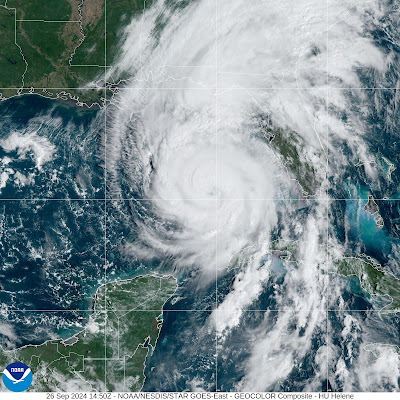 |
Satellite view of Hurricane Helene entering the southern
Gulf of Mexico early this afternoon. It's a monster,
and getting stronger |
Hurricane Helene is about to become the nation's next multi-billion dollar disaster.
As of late this morning, Helene, freshly upgraded from a tropical storm to a hurricane with top winds of 80 mph, was scooting northward past Cancun, Mexico and heading into a storm-welcoming Gulf of Mexico.
Florida, of course, is most under the gun, since Helene is expected to make landfall sometime Thursday evening in the Big Bend area.
That's the part of northwest Florida that curves from the Gulf Coast panhandle southward to start forming the main Florida peninsula.
It's not just that estimated landfall point that's in danger. This punishing storm is about to cause widespread destruction throughout much of the Southeast.
Everything about this storm so far is bad news, frankly.
WHY IT'S BAD
All the ingredients are there for Helene to explode in strength today and tonight as it makes its way northward through the eastern Gulf of Mexico.
Water temperatures are at record high levels. The hotter the water, the better chances that a hurricane can grow strong, given the right atmospheric conditions.
Those atmospheric conditions are just right to nurture this rapidly growing hurricane. Upper level winds are light, so there's nothing up there to disrupt the swirling thunderstorms that construct the storm.
Sometimes, areas of dry air just outside a hurricanes' circulation gets pulled into the storm, weakening it. There's really no drier air surrounding Helene to threaten its growth rate.
High above Helene is something called upper level divergence. That means air is moving outward away from the storm and its path. That allows air in Helene to rise into all the more tall thunderstorms, helping it get stronger.
This combination of factors are conspiring to make Helene a true, dreadful danger, with a bunch of hazards, some of which we explain next:
STORM SURGE
Storm surges are usually the most destructive part of a hurricane. The ocean, fortified with huge, battering waves, invades coastal communities with feet of water. Pretty much everything in their path is destroyed, and if you're caught in a hurricane storm surge, chances are you won't survive.
That's why there's so many evacuations going on in coastal western and northern Florida. Mandatory and voluntary evacuation orders are in effect in large swaths of 13 Florida counties, including heavily populated Sarasota and Charlotte counties.
The path, size and strength of Helene are all conspiring to make a near worst case scenario for storm surges in Florida.
 |
Hurricane Helene's projected path as of noon today.
Note that the storm's effects will be felt far
beyond the center of its path. |
Helene is large in area, so it can stir up and push a lot of Gulf Water toward the coast.
Where and just east of where Helene comes ashore, the storm surge could go as high as 15 feet. Which is really bad considering the land doesn't rise much in elevation near the shoreline.
Helene will go west of Tampa, meaning the winds will come from the south. Those winds, along with the coastline's orientation, will shove a LOT of water up into Tampa Bay.
Storm surges there are expected to be in the five to eight foot range, which would flood thousands of buildings.
Storm surge warnings are up for the entire west coast of Florida. That involves an incredible amount of property, so just the storm surge, never mind anything else, could cause $1 billion or more in damage.
WIND
Top winds with Hurricane Helene at landfall could be 125 mph or greater - a major Category 3 storm. There's a fairly decent chance that Helene's rapid intensification could over-perform, creating a Category 4 storm with winds of 130 to 156 mph.
There's even a quite low but not zero chance it could turn into a Category 5 - the worst kind - with winds of at least 157 mph.
Helen's large size will also mean strong, damaging winds will hit an unusually large area for a hurricane.
As the Washington Post explains:
"....its size could be in the top 10 percent of hurricanes observed in the region, according to the National Hurricane Center. That means its surge and wind impacts will be greater more more wide-reaching that typical.
Tropical storm force winds could extend more than 200 miles from the center, and tropical storm warnings even extend into Miami, far from where Helene will come ashore. Tropical storm watches also stretch into coastal Georgia and South Carolina.
Helene is forecast to barrel inland at high speeds, allowing severe winds to penetrate much farther inland than typical for a hurricane across eastern Georgia. It could be Georgia's most serious weather event in quite awhile, with gusts of 80 to 90 mph possible over southeastern portions of the state."
Damaging winds will probably punch even further north. Just before noon, tropical storm watches were extended northward to encompassing all of Georgia, including metro Atlanta, and the high elevations of the western Carolinas.
All this areas could see winds of 58 to as much as 80 mph with locally higher gusts. Soggy ground combined with the high winds will make lots of trees in these heavily forested areas topple. Some of them will surely crush parts or all of houses, buildings, power lines and other structures.
FLOODING
Intense inland flooding looks inevitable through huge swaths of Florida, Georgia and the southern Appalachians.
Helene as of noon wasn't even anywhere close to Georgia and the southern Appalachians and already serious flooding is breaking out there.
They're experiencing a classic and dangerous predecessor rain event or PRE. These happen when deep moisture is drawn far northward from the developing hurricane and that moisture smacks into a stalled weather front or mountains or a combination. These usually happen more or less 500 or more miles north often actual hurricane.
The southern Appalachians have already had two to five inches of rain in the past couple of day, and expect downpours that will deposit another three to six inches of rain for the rest of the day. Flash flooding was already ongoing near the Tennessee/North Carolina border this morning, and it will get worse this afternoon.
Then, by Thursday and Friday, the actual storm center of Helene will pass through the region. By later Friday, six inches to as much as a foot of rain, possibly with locally higher amounts will drown the southern Appalachians, This will cause catastrophic flash floods in the steep terrain, along with landslides.
You surely remember how this type of downpour, with water rushing off of Vermont's steep mountains, caused the catastrophic floods in the summers of 2023 and 2024. The southern Appalachians will experience something like that, except maybe even worse.
TORNADOES
Hurricanes that come ashore often spin off a number of tornadoes, especially near and east of the storm track. Florida, eastern Georgia and the Carolinas are under a tornado threat Thursday and Friday.
BOTTOM LINE
Unless something unexpected happens, this is frankly a mess. The forecasts have been consistent, and there's not a lot of spread in the various computer models. Sure, there will be surprises, but nobody should be shocked that Helene will create yet another huge path of destruction.
Climate change, by the way, isn't "causing" Helene. But the extreme heat content of the Gulf of Mexico waters, likely brought on by climate change, are contributing to making this hurricane worse than it would otherwise be.
Also, a warmer world can carry more atmospheric moisture than a cooler world. With or without climate change, Helene would cause a lot of flooding in the Southeast. But perhaps because of climate change, the flooding could be more intense than if the same weather situation hit decades ago.
I'm really hoping the millions of people caught in the crosshairs of this storm heed all evacuation warnings, and do what emergency managers tell them to do.
This one is a pretty scary one, folks.





















